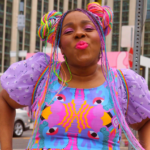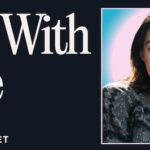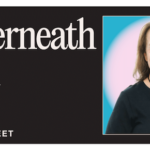Amina Mucciolo
Artist
-
Meet and Greet

Did you know that one of the most common color associations used to represent autism is the rainbow? In fact, the range of colors inside one highlights the amazing abilities and different diagnoses on the autism spectrum, as well as the varying challenges each person faces.
Artist Amina Mucciolo (they/them) knows all too well about a few of those challenges. “Growing up, I didn’t really have any friends,” they say. “Making friends had always been such a hard thing for me, until I decided to make it part of my job. Now, connecting with people is one of the most magical parts of what I get to do.”
And just how no one sees the same rainbow, no one autistic person is the same. “Our experiences are very different, and they vary based on our lives and the things that have happened,” they say. So, in honor of Autism Acceptance Month, we got to learn more about what makes Amina, their thoughts and takes, and their artwork unique, as well as finding out how fitting their fave color is. 🌈
Can you tell us a bit about your autism diagnosis?
I was 35 years old when I found out I was autistic. It was a life-changing event, to find that out later on in life. I was well in the middle of my career as an artist and content creator. To be honest, it was a lot to adjust to and really hard at first. I didn’t really want to accept it because I didn’t even understand what autism was, but it was such a relief when I finally did some research and started reading and seeing other autistic adults on social media talking about their experience, how they’ve had to change their lives, and what works for them.
Even though there’s more medical information nowadays, there’s still not a lot of resources. On top of that, it was a long journey for me to be diagnosed because I was misdiagnosed for so many years. Adjusting my life to meet my needs as an autistic adult was really the first time I started to see things become a little bit easier for me. And ultimately, it was one of the best things that ever happened because it made my life and myself make a lot more sense.
A big part of your life is your art. When did you first start creating?
I’ve always been creative and drawn to art and color. It wasn’t until my mid-20s, after I had gone through a lot of mental health issues and struggles that I found the courage and strength to commit to making it something I wanted to pursue professionally.
It started with making things that I enjoyed, like jewelry. Then, I would make things for my space. That’s actually how I started making things like tassel garlands. I would share them online, “Oh, look. I made this for my home,” and people would be really into it. From there, every little thing I did grew my confidence. Now, I basically do anything I want with art that I’m interested in or brings me joy.
You have a huge following on social media where you spread love, awareness, and bright and bold colors. What do you do when social media gets too overwhelming?
To share your thoughts or your art with hundreds of thousands of people is a hard thing to do. I think that I do it anyway because that’s what helps me feel more connected to what I’m doing. I also think about the people who are going to receive it. But not everyone remembers that there’s another human on the other side. When I feel overwhelmed, I take a step back. I do something that grounds me, like trying to connect with nature or things that I really love, and then I come back with a fresh spirit. Sometimes you have to take a break from social media because even though it can be a huge part of your career, you can’t ever put that above your health. Nothing’s more important than you feeling okay.
Speaking of bright colors, which one is your fave?
I get asked this a lot [laughing]. I would say that pink, lilac, and lavender are my neutral colors, but my favorite color is rainbow.
What can be done to make the world a more accepting place for autistic people?
The most important thing is listening to autistic people. Working as an autistic artist, I’ve learned that there’s not a lot of systems in place when working with others, and many people aren’t always willing to accommodate. For me, it’s very hard because sometimes I miss out on opportunities because brands aren’t prepared to work with an autistic person. They want to hear from an autistic person, but they don’t want to do what’s necessary in order to accommodate us.
What’s a piece of advice you have for those who are autistic, have autistic children, or just know and love someone with autism?
Have patience, an open mind, and don’t make assumptions. Again, listen to the autistic people in your life. To the people who are autistic that are listening, I love you. Try to give yourself as much grace as you can. Try to be as patient with yourself as you can. I know it’s a tall order, but take your time. It’s okay. Whatever it is will be there.
I wish someone would have told me all of those things when I was first diagnosed. That it was okay to take my time, say no to things, and give myself more grace and compassion. The world is so hard on us already, and we don’t need to add to that.



